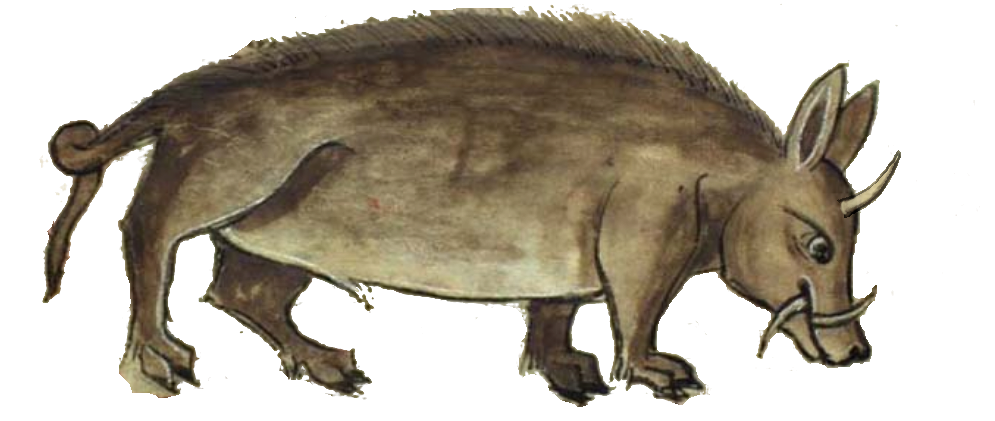Kernu
Yawru lay at the bottom of the river, staring up at the boar drinking a few feet upstream from him. His kelp-like hair floated above him, helping obscure his face in case the kernu happened to look downstream — not that their vision was all that good anyway.
Yawru had been stalking the tusker for hours. Now was his chance: he slowly floated up and stepped onto firm ground, lining up the boar in the bronze sights of his crossbow. A well-placed bolt to the heart would take it down quickly.
His finger pressed down smoothly, but just as the bolt released a bird fluttered out of the bushes, causing the boar to pivot toward it. Bad luck; the bolt richoceted off a bone in the animal’s shoulder.
Provoked by the pain, the creature turned toward the twang of the bowstring. It charged at Yawru, lowering its swooping, sharp horns as it barreled toward him.
Yawru had a backup plan: he gripped his spear, lowering the butt calmly but quickly into the tree behind him and dropping the blade to eye-level between the kernu’s tusks. The broad crossbar on the spear was designed for hunting kernu, to prevent them from running up on the spear and impaling their hunter. Usually it worked. Occasionally it didn’t.
Unfortunately, today turned out to be “occasionally.”
The creature’s hard skull held firm against the point, and the shaft splintered into a half-dozen useless pieces. Yawru dove away, yelping as one of the horns left a deep gash across his thigh.
He drew his sword and backed up against another tree as the boar turned to face him again. Unlike the spear, the sword wasn’t specially designed for the hunt. It didn’t look much longer than the kernu’s own horns, which meant Yawru would have to get uncomfortably close to finish the job. Thankfully he had one more trick up his sleeve.
As the boar charged at him, Yawru vanished. The creature rammed headlong into the tree behind where he’d been, snapping off one horn and stunning itself with a loud thud. Yawru reappeared behind it, sword slicing up into the thing’s neck from the side.
It was a shame about the horn; a pair this long in good shape would’ve been a beautiful prize. But the Mahksi would feast tonight.
The kernu is a fierce, boar-like animal that lives in the environs around Moru Kel. They’re easily distinguished from a standard boar by the twin “horns” (really tusks) that jut out from their brow-line. A civic symbol of Moru Kel, they lend their name to the twin spires — the Kernu Apsu — that rise from the sides of the entrance to Kilpo Bay.
 They also give the name tusks to the ivory tiles used for divination and game-playing in the city — such tiles were originally crafted from the ivory of kernu tusks.
They also give the name tusks to the ivory tiles used for divination and game-playing in the city — such tiles were originally crafted from the ivory of kernu tusks.
Kernu range in size based on the availability of food and other factors. A typical adult male weighs 250–300 lbs., is 5' in length, and stands about 2 1/2' at the shoulder. The largest verified specimen was over 750 lbs weight, stood almost 4' at the shoulder, and was a massive 8' long. Females tend to be about four-fifths the overall size of males. A long, narrow row of stiff bristles runs down the back of the kernu, with its size, color, and prominence varying by individual and time of year.
Kernu males are solitary outside of mating season. The females travel in packs with juveniles, protecting the young for the first year of their life.
Kernu are omnivores, happily eating whatever they come across. They live approximately 7–10 years in the wild.
By far the most interesting physical characteristic of the kernu are its many tusks: in addition to the pairs of extended teeth coming up and down from its mouth, the kernu features another set of tusks on its forehead. Jutting up like scimitars, these usually extend 4–6" from the forehead but in some cases are over a foot in length.
The tusks are used in battles for mates, for defense against predators, and to dig in the ground for grubs, worms, and insects. Outside of mating battles they are rarely used offensively unless the animal is desperate.
Hunting of the kernu is a dangerous proposition: like the boar, they can survive seemingly grievous wounds, and will continue fighting long after most other animals would have expired. The use of pits and barriers is common to avoid tragedy during hunts. Among the Seta, spear-hunting is common; the Seta boar spear has a powerful cross-stop to prevent the beasts from impaling themselves on the spear to gore their attacker.
Regardless of the danger, the hunt is well worth it. The flesh of the kernu is a delicacy, with a richer flavor than any of the lizards around Moru Kel or even than that of the sheep or goat. Their tusks are much-valued for their ivory, which is used in the making of jewelry, gaming tusks, and other luxuries.
The kernu is not readily domesticated.
↞ Previous: Goanna Next: Kolibri ↠